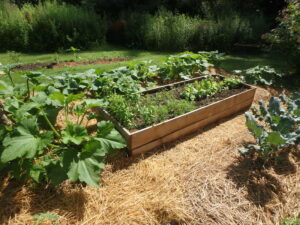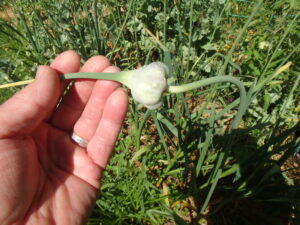What You Should Be Doing Now in the Vegetable Garden
Posted on Tuesday, July 26, 2022 · Leave a Comment
Heat descended on us recently like opening the door to a roaring woodstove. The old adage about colonial India was, “Only mad dogs and Englishmen go out in the noon day sun.” I think that applies here, too. I, for one, have no desire to work in the garden when temperatures get to be in the eighties or more.
My strategy is to go bed earlier, and get up at 6am – or even earlier if I can. In general I’m not a morning person. I like coffee, the newspaper in my hands, and a leisurely breakfast. But with the heat, I feel a need to see what plants need some water, and what veggies should be picked early in the day.

Raised beds need more water than plants in the ground.
The most vulnerable plants are those that have just been transplanted or installed. I recently moved some small Swiss chard plants from a somewhat shady place to a raised bed in full sun. Gravity works on water, not just Newton’s apple. Raised beds tend to drain of water and dry out faster than beds in the ground. The soil is warmer, too. So those Swiss chard seem to need water every day now.
I can reduce my need to water that raised bed by mulching it well. I’ve mulched the rest of my vegetable garden with four to six pages of newspaper, covered with straw or hay. That is primarily for keeping the weeds down, but it also reduces the need for watering. But the raised bed was built later, and I haven’t mulched it yet. Gotta get on it!
I also regularly water a bed of zinnias that were only planted by seed in June. Anytime you plant seeds, you should water daily until they germinate to avoid drying out the seeds at a critical time. And when the plants are small, they need regular watering, too.
We have thinned all our root crops by now, which is important. If you haven’t, you should. Carrots, beets, parsnips, radishes and rutabagas need room to grow – an inch, at least, from their nearest neighbors. You can eat the small vegetables you pull. The leaves of beets are a tasty treat when steamed lightly and served with butter.

Garlic scapes like this are tasty when chopped and added to a stir fry.
I’m harvesting garlic now, too. Not the entire crop as yet. I just pull one or two for cooking as needed. I’ll pull them all in August when the leaves start to brown up. When I pull the main harvest I leave the tops on and hang them in the cellar upside down to cure. I’ve read that the bulbs will absorb additional nutrients from the leaves and stem while they cure.
Fresh garlic is nearly impossible to peel. I just use a sharp paring knife to make 2 slices into a bulb – one on each side of a clove. When it pops out, I can peel off the outer layers and insert the clove into a press, or smash it with the wide blade of a French kitchen knife and then chop it finely.
I’m often asked if cutting off scapes, those curly tops of garlic, helps to grow bigger, better bulbs of garlic. I’ve been experimenting with that for years, and don’t see a significant difference. So I cut off scapes to use in stir fries, salads or stews, but don’t bother to remove them all.
I picked a few ‘Early Girl’ tomatoes in mid-July this year, which is early, even for them. Although I started almost all my tomatoes by seed in April, I did buy a few bigger plants to get those early tomatoes. Next up will be my ‘Blue Beauty’ tomatoes, which I did start by seed indoors. They are a gorgeous deep purple, with green at the bottom. When the green turns red and they soften up, they will be ready to pick.
For once I have planted lettuce regularly all summer, so I have had enough to eat and to share. And I have lots of small plants to transplant and separate. I recommend that you plant some lettuce seeds directly in the ground now for early fall eating, and in a month, do it again. Mark your calendar! After all, some spaces will be opening up in the garden as you harvest radishes, peas, beets and more. Look for heat resistant or hot weather lettuce varieties like Adriana, Monte Carlo or Red Cross – all available from Johnny’s Seeds. Cool weather lettuce quickly bolt in August heat.
I am picking heads of broccoli now. But the best if yet to come. I once made a little garden in the lawn for an elderly friend, and planted 2 broccoli plants there. Unfortunately, my friend pulled out the broccoli once they had yielded their first big heads. Little did she know that broccoli will send out side shoots, smaller spears of broccoli, for the rest of the summer and fall! Just keep on picking. And if the side shoots start to open with yellow blossoms, pick and eat them anyway. They will still be tasty.

Potatoes will be ready early this year. Start digging them after they flower.
I seem to be having a great year for potatoes (I have not seen a single potato bug), and should have plenty to eat and share. I planted 100 chunks of potato, and each plant should give me one to two pounds of spuds. I will start harvesting a few after they have blossomed. I like to slip my hand under a plant and “steal” a potato or two for dinner before I start the harvest. If you grow potatoes, be sure to let your children or grandkids help you when you harvest them. All kids are excited by the buried treasure!
So beat the heat: get up early and go out to your garden. There is always something to do.
Henry is a lifelong organic
gardener, and a 20 year veteran of the UNH Master
Gardener program. He is the author of 4
gardening books. Reach him at
henry.homeyer@comcast.net.





